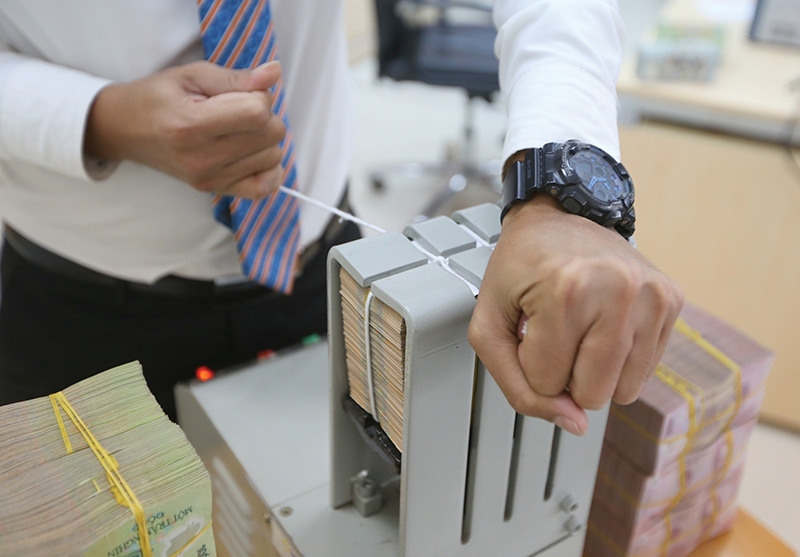Watchdogs notice stable credit growth
 |
| The SBV estimated that by the end of June, credit for several economic sectors increased by up to 14.5 per cent. Photo: Dung Minh |
“More than 10 credit institutions have proposed loosening their credit room as they are proactively implementing a wide range of activities – which is a positive sign of the domestic economy picking up,” said Pham Thanh Ha, director of the Monetary Policy Department under the State Bank of Vietnam (SBV) in the central bank’s first six-month review conference held last week.
In the first quarter, the SBV assigned the first credit limit target to banks in the system. Techcombank had the highest credit growth room at 12 per cent, followed by TPBank with 11.5 per cent. In addition, Vietcombank, MB, and MSB were assigned 10.5 per cent.
SSI Research assessed that the SBV maintains a flexible forex policy which allows for reasonable fluctuations with fewer and more market-based interventions, along with a supportive credit policy. This means a loosening could come and the credit growth quota be extended further.
Deposit interest rates thus will remain stable in the short term but may increase in the second half when commercial banks are allowed to increase credit room, SSI predicted.
Data compiled by the SBV shows that money supply growth by June 15 was 3.96 per cent year-to-date and 14.27 per cent on-year, whereas credit growth was 5.1 per cent year-to-date (compared to 2.26 per cent in 2020) and might reach 15 per cent on-year. This is clearly higher than the 9.5 per cent in 2020 or the 11 per cent in 2019 for the same period.
“Generally, a low-base impact might be one reason and 2019 growth might not be a good proxy when we talk about pre-pandemic levels. Consider that 2018 provided an extremely high base, with approximately 18 per cent growth on-year, with major growth originating from property loan which were up 26.16 per cent on-year for 2018,” noted Hung Pham, analyst at SSI Research.
Nguyen Tuan Anh, director of the Credit Department for Economic Sectors under the SBV, said credit would be focused on priority segments, such as manufacturing. “A 12-per-cent credit growth on-year is achievable and given the favourable conditions and the demands of banks, we would consider lifting the credit quota above 12 per cent. Banks with sound financial capacity will be granted a higher credit room,” said Anh.
Previously, some banks said that they have reached almost two-thirds of their credit room for the whole year in the first five months and have requested more legroom.
Experts believed the recent increases in the charter capital of local banks have also boosted their demand to raise credit room.
In the future, the SBV will have a solution to continue directing credit institutions to closely monitor lending activities in risky areas while strengthening inspection and supervision measures, and borrowers use them for the right purposes, Anh emphasised.
“The risky sectors eliciting the greatest concerns are property and securities trading. This is nothing new, however, as the central bank has simply reiterated its view that loans for securities trading are to be kept unchanged at 0.48 per cent of total outstanding loans or $2 billion,” Pham of SSI said.
“For property loans, growth might be larger at 6 per cent year-to-date by the end of June but not significantly higher than that if system-wide credit growth is 12 per cent.”
In the first quarter, MSB, MB, and Techcombank recorded the highest loan growth, so they are likely to be allowed to further expand credit growth, according to SSI Research.
On the other hand, Viet Capital Securities Company (VCSC) believes TPBank will be approved by the SBV to expand credit from 11.5 to 26 per cent in 2021.
Other banks have also set growth targets in excess of 20 per cent such as VIB (31 per cent), Kienlongbank (28 per cent), HDBank (26 per cent), OCB (25 per cent), and VietBank (22 per cent).
Lower credit growth room has forced some banks to boost cross-selling products, particularly bancassurance, which will improve loan access for policyholders and also help promote disbursement procedures, VCSC noted.
“We also noticed there was not much discussion or concern over inflation and it implies the SBV believes that the inflation target of 4 per cent is within reach,” said Pham of SSI.
The SBV estimated that by the end of June, credit for small- and medium-sized enterprises, export businesses, supporting industries, and high-tech and innovative businesses would increase by 3.9, 9, 6.94, and 14.5 per cent, respectively.
What the stars mean:
★ Poor ★ ★ Promising ★★★ Good ★★★★ Very good ★★★★★ Exceptional
Related Contents
Latest News
More News
- Vietnam’s green transition demands collective financial action (December 15, 2025 | 12:00)
- VIR workshop highlights capital and policy for sustainable development (December 15, 2025 | 11:00)
- National Assembly approves pilot mechanisms to accelerate major projects in Hanoi (December 12, 2025 | 11:29)
- Vietnam eases policy approval requirements, simplifies foreign and outbound investments (December 11, 2025 | 17:53)
- Unpacking new momentum in Vietnam’s M&A market (December 10, 2025 | 09:59)
- Forum honours outstanding M&A deals, strategies, and advisory firms (December 09, 2025 | 18:22)
- Vietnam enters defining phase of M&A growth (December 09, 2025 | 17:00)
- Vietnam’s M&A market opens new opportunities amid strong economic momentum (December 09, 2025 | 15:00)
- Vietnam M&A Forum 2025: new position, new momentum (December 09, 2025 | 14:30)
- FDI in Vietnam jumps on additional capital and share purchases (December 09, 2025 | 13:56)

 Tag:
Tag:





















 Mobile Version
Mobile Version